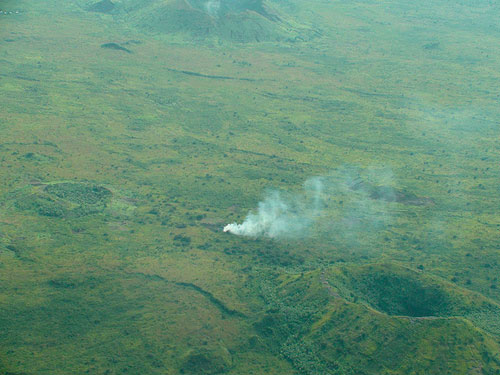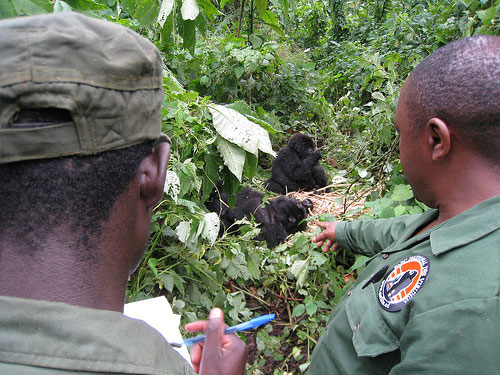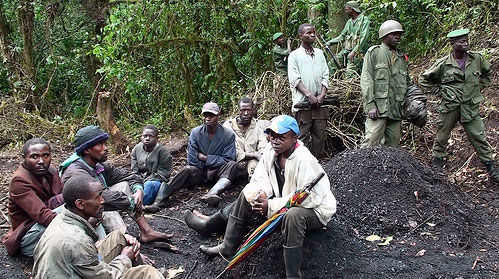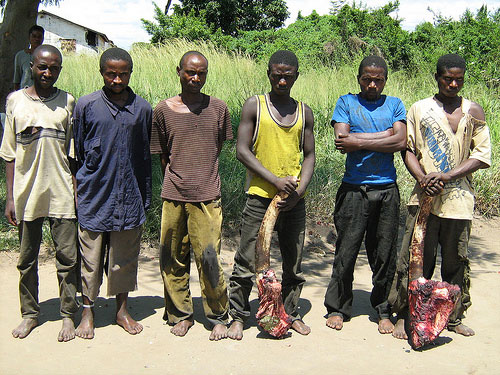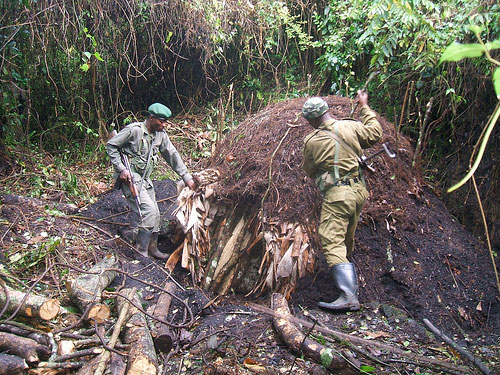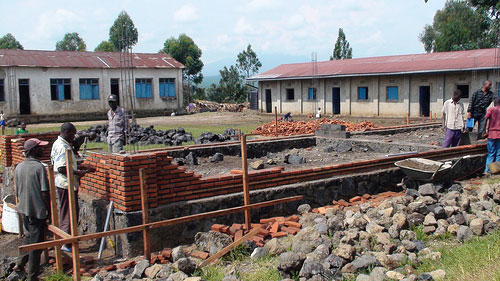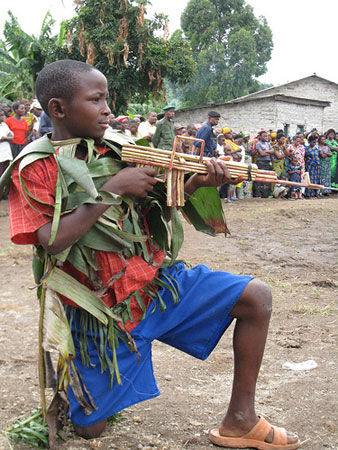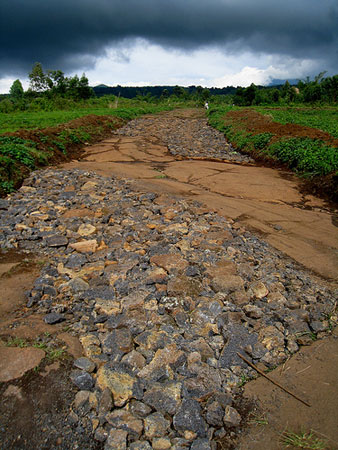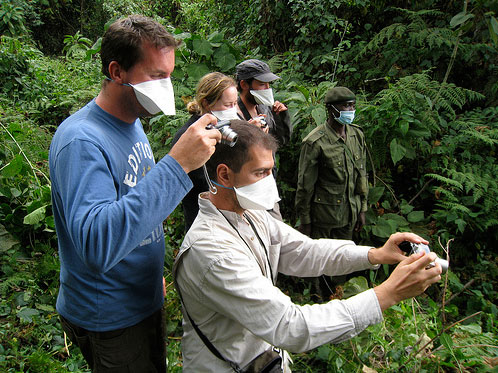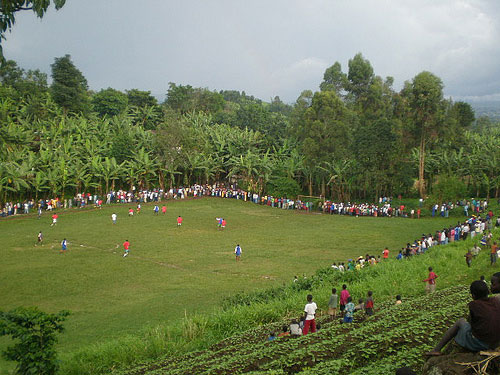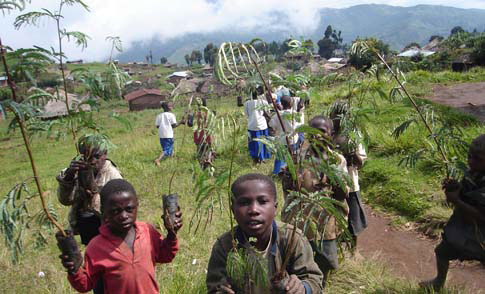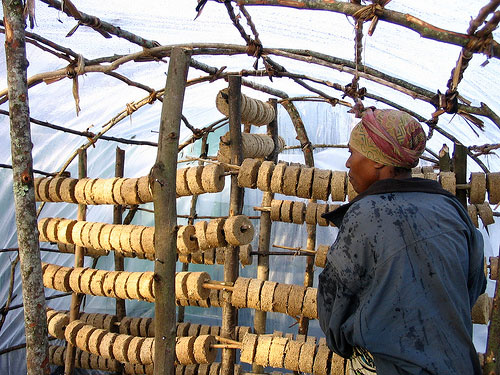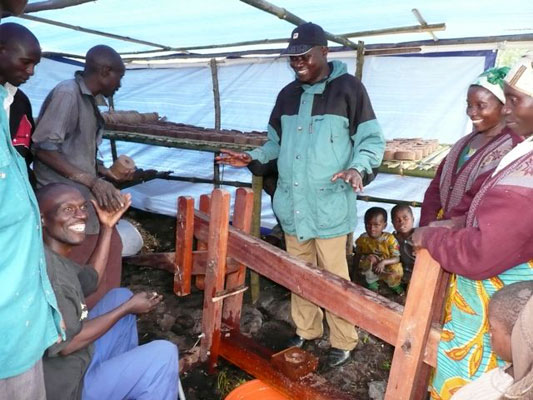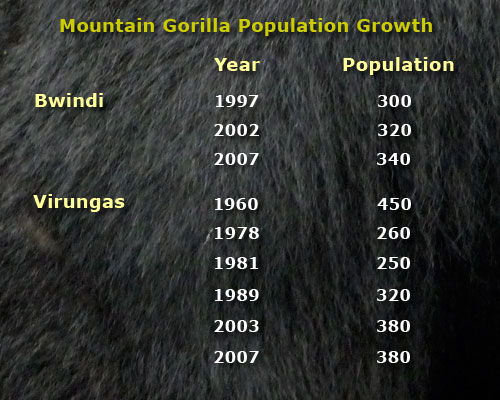|

- Intro
- Population Increase
- Habitat Preservation
- Eco-Tourism
- Law Enforcement
- Education
- Organizations
- Please Help
The year 2002 marked the 100th year since the mountain gorilla was first discovered and scientifically identified as a distinct subspecies of gorilla. 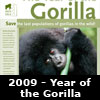 Although great challenges continue to threaten the gorillas, organizations and individual people around the world are combining their efforts to help ensure the survival of this precious species. There are numerous reasons to be optimistic. Perhaps the biggest reason is awareness. After the worldwide publicity of the July 2007 massacre in DR Congo, international conservation organizations joined hands to declare Although great challenges continue to threaten the gorillas, organizations and individual people around the world are combining their efforts to help ensure the survival of this precious species. There are numerous reasons to be optimistic. Perhaps the biggest reason is awareness. After the worldwide publicity of the July 2007 massacre in DR Congo, international conservation organizations joined hands to declare
2009 the Year of the Gorilla.
Census results indicate a continued steady increase in the population of mountain gorillas in Bwindi Impenetrable National Park. The first complete census was conducted in 1997. The population increased 12% by 2007, representing a 1% annual growth rate. Although this is indicative of a reasonably healthy and well-protected population, researchers believe that gorilla populations are capable of growing at 3-4% under optimal conditions.
The Virungas population, comprised of gorillas from 3 national parks in 3 countries, has seen the number of animals fluctuate over the years. The population decreased between 1960 and 1981 mainly due to poaching and habitat loss. Thanks in part to Dian Fossey, the numbers climbed in 1989 and then again in 2003, before leveling off in 2007. Given the 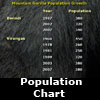 fact that this area has been besieged by violence and disease resulting from ongoing wars, this can be considered good news. Furthermore, it was found that the group of gorillas that were the victim of the July 2007 massacre is recovering. The Rugendo family is up to nine members, up from five in the last count. The largest family is the Kabirizi Family, with 33 individuals including 5 newborns. fact that this area has been besieged by violence and disease resulting from ongoing wars, this can be considered good news. Furthermore, it was found that the group of gorillas that were the victim of the July 2007 massacre is recovering. The Rugendo family is up to nine members, up from five in the last count. The largest family is the Kabirizi Family, with 33 individuals including 5 newborns.
It is believed that the Virungas area has a natural density of about 450 gorillas. This is because the total protected area of the Virunga Mountains is only around 780 sq km and is surrounded by dense agricultural land. That leaves the current population of 380 with room to grow. Hopefully with proper management the population will again see a steady increase and approach the potential number of 450. The future of the gorillas is most dependent on the protection and survival of the forests in which they live. Because the parks are little islands 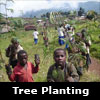 of wilderness surrounded by crowded areas with lots of farmland, the challenges facing the species are complicated. There is no future for the parks without local support. And the local people are beginning to realize that they can get more benefits from preserving the forests than they can by clearing them for farmland. Continued education and involvement of the local population, combined with enforcement of existing laws, will ensure that the gorillas will always have a home. of wilderness surrounded by crowded areas with lots of farmland, the challenges facing the species are complicated. There is no future for the parks without local support. And the local people are beginning to realize that they can get more benefits from preserving the forests than they can by clearing them for farmland. Continued education and involvement of the local population, combined with enforcement of existing laws, will ensure that the gorillas will always have a home.
Perhaps most important in the struggle to preserve the forests are new technologies designed to replace traditional firewood and charcoal. One of these is solar ovens, which use the power of the 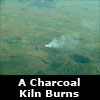 sun to cook and boil water. These can either be made locally with cheap materials, or purchased with the help of aid organizations. Fuel briquettes are a low cost, locally made fuel for cooking and heating that offer another alternative. They are made from weeds, leaves, sawdust, rice husks and scrap paper. The process of making them involves: sun to cook and boil water. These can either be made locally with cheap materials, or purchased with the help of aid organizations. Fuel briquettes are a low cost, locally made fuel for cooking and heating that offer another alternative. They are made from weeds, leaves, sawdust, rice husks and scrap paper. The process of making them involves:
- collecting the materials
- pounding or grinding them
- mixing the materials with water
- allowing the mash to sit for a period of time
- pressing the mash into a fuel briquette using a specially designed press
- allowing the briquettes to dry
- burning the fuel briquettes exactly as one would burn firewood or charcoal
Gorilla eco-tourism has played a major role in the recent success at stabilizing the populations. This has brought much needed revenue into this impoverished region, which has led to some innovative programs created by UWA, ORTPN, and to some degree ICCN, that benefit the local populations:
- Involve local communities: local representatives are encouraged to participate in park management decisions.
- Revenue sharing: a portion of tourism revenue is given to neighboring communities for development projects.
- Develop infrastructure for local communities: the park helps build and maintain local roads as well as water pipelines from sources inside the park.
- Regulated harvesting of forest resources: local farmers are allowed into the forest periodically to harvest things such as bamboo and honey on a limited basis.
- Creating jobs: the parks directly employ local people.
- Generating auxiliary income: tourists spend money on hotels, restaurants, arts and crafts and other services in the local communities.
- Cross border communication: managers from the three countries’ national parks hold occasional workshops and meetings to discuss common problems and challenges.
Eco-tourism also brings risks to the gorillas that need to be mitigated. To further limit the chance of humans passing diseases on to gorillas, new policies that strictly control tourists may be needed. Training and monitoring of guides could be improved to keep tourists the required 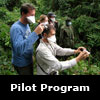 7 meters away and to watch for tourists that may be ill. Medical screening or vaccinations could become mandatory for visitors wishing to see gorillas. Without appropriate safeguards, it is possible that well-meaning tourists who believe they are supporting gorilla conservation will unwittingly contribute to their decline. 7 meters away and to watch for tourists that may be ill. Medical screening or vaccinations could become mandatory for visitors wishing to see gorillas. Without appropriate safeguards, it is possible that well-meaning tourists who believe they are supporting gorilla conservation will unwittingly contribute to their decline.
Despite the risk of infection, tourism is essential in creating the economic incentives that allow for gorilla protection. Banning it would most likely lead to the extinction of mountain gorillas in their natural habitats.
Credit must be given to the dedicated anti-poaching and forest preservation efforts by national park authorities, especially the ORTPN in Rwanda and the UWA in Uganda.
But it has been the heroic efforts on the part of the rangers of the ICCN in the DR Congo that deserve special mention. Not only have they worked diligently protect the park from poachers, charcoal producers, and incursions by armed militias, they have done this while receiving little 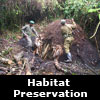 or no pay for extended periods of time. They have also faced incredible danger; some 150 of them have died in eastern DR Congo in the line of duty since 2000. Increased political stability will help the rangers more effectively manage and protect the park. or no pay for extended periods of time. They have also faced incredible danger; some 150 of them have died in eastern DR Congo in the line of duty since 2000. Increased political stability will help the rangers more effectively manage and protect the park.
Mountain gorillas are legally protected in the three countries where they live. Laws cover poaching, illegal trade in the animals, and illegal habitat destruction. Follow-up of the legal process through arrest and prosecution is better served in Rwanda and Uganda than in DR Congo.
The Agreement on the Conservation of Gorillas and Their Habitats, also known as the Gorilla Agreement, is an international treaty that binds the Parties to conserve gorillas in their territories. It was concluded in 2007.
Ever since Dian Fossey started studying the mountain gorillas in the late 1960s, scientists and students from institues and universities around the world have made the mountain gorilla a focus of their research. Studies have included:
- How gorilla groups are formed
-
How males and females choose mates
-
How infants are raised
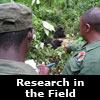 -
How the gorillas communicate
-
How the gorillas communicate
In addition to the ongoing research about mountain gorilla life, scientists are now using some of the most up-to-date scientific methods to learn even more. For example, a study is currently underway using DNA samples of gorillas' feces, in order to learn the exact paternity for each new infant born in a gorilla group. Scientists are also attempting to classify all of the plants in the forests, upon which the gorillas and other species rely for food.
While conservation activities have contributed to the stability of gorilla populations, this could change quickly due to the current insecurity and instability in eastern DR Congo, or a natural disaster such a major volcanic eruption. Constant vigilance is needed to ensure mountain gorillas’ survival.
igorilla.org has chosen the Gorilla Doctors as its sole beneficiary of donations. The Gorilla Doctors has been operating in Africa since 1986 and began a partnership with UC Davis in April 2009. Please donate any amount that is comfortable for you. It would be appreciated if you could state that your donation is in honor of igorilla.org so that we may track our efforts.
|
|
|
n. A person or organization that derives
advantage from something, especially
a trust, will, or life insurance policy.
n. The action or state of keeping careful
watch
for
possible danger or difficuties.
n. The state of being a father; fatherhood.
n. Short for deoxyribonucleic acid. It is
the material in almost all organisms
that carries genetic information.
v. Impose a legal or contractual obligation.
adj. Having or showing care and
conscientiousness in one's work or duties.
adj. Devoted to a particular task or purpose.
adj. Absolutely necessary, extremely important.
n. A thing that motivates or encourages
someone to do something.
adv. Of a person, not aware of the
full facts. Not done on purpose.
Unintentional.
adj. Required or commanded by authority; obligatory.
v. To make less serious, severe, or painful.
300 sq miles
v. To surroundand harass with hostile
forces.To crowd around.
v. To vary irregularly. To rise and
fall as if in waves; undulate
All of the countries where either lowland or mountain gorillas
live signed the agreement. These include the Central African
Republic, Republic of Congo, Democratic Republic of
Congo, Equatorial Guinea, Nigeria, Rwanda, and Uganda.
The Rwandan Office of Tourism and National Parks
(Office Rwandais Du Tourisme Et Des Parcs Nationaux),
has partnered with the Mountain Gorilla Veterinary Project
to care for orphaned gorillas.
The Uganda Wildlife Authority has hired its first local
Batwa (pygmy) tribesman as a park ranger.
n. the number of animals a given
habitat can sustainably support.
n. an official count or survey of a population

